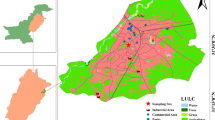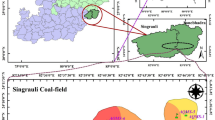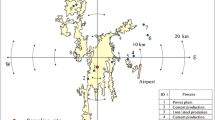Abstract
In order to trace the origin of Particulate Matter (PM) in Korea, the research was conducted to analyze the nuclide of PM samples. To analyze the PM sample, we performed Backtracking Analysis and Gamma spectroscopy. PM is affected by the size of the atmospheric mixing layer height and the air flow according to the air mass. The air flow of the 2 seasons (summer and autumn) was predicted by using Hysplit (backtracking analysis). And the radioactivity of nuclides in the PM sample collected from the measuring site is confirmed using gamma spectroscopy and radioactivity calculation method. Takuya (J Nuclear Radiochem Sci, 8(1):5–9, 2007) As a result of analyzing samples collected in 2 seasons, it was confirmed that the radioactivity of specific nuclides changed according to the season and was affected by air flow. In conclusion, the origin of PM can be estimated by confirming the change in PM and nuclides.



















Similar content being viewed by others
References
Takuya A (2007) Highly time-resolved measurements of airborne radionuclides by extremely low background γ-ray spectrometry: their variations by typical meteorological events. J Nuclear Radiochem Sci 8(1):5–9
Takuya A (2010). Relationship between variations of 7Be, 210Pb and 212Pb concentrations and sub-regional atmospheric transport: simultaneous observation at distant locations, https://doi.org/10.1016/j.jenvrad.2009.09.004
Kim MJ (2019) The effects of transboundary air pollution from China on ambient air quality in South Korea, https://doi.org/10.1016/j.heliyon.2019.e02953
Park Y-H (2016). An analysis of long-term variation of PM10 levels and local meteorology in relation to their concentration changes in jeju, https://doi.org/10.5322/JESI.2016.25.1.107
Ho EC, Measday DF (2004) A simple model for describing the concentration of 212Pb in the atmosphere, https://doi.org/10.1016/j.jenvrad.2004.05.008
Zhang W (2015). Estimation of the Arctic aerosols from local and long-range transport using relationships between 210Pb and 212Pb atmospheric activity concentrations DOI https://doi.org/10.1016/j.jenvrad.2014.12.008
Song J-M (2021). Concentration Variability of Atmospheric Radon and Particulate Matter at Gosan Site in Jeju Island during 2016–2020, https://doi.org/10.5572/KOSAE.2021.37.6.907
Stein AF (2015) NOAA’s HYSPLIT atmospheric transport and dispersion modeling. System. https://doi.org/10.1175/BAMS-D-14-00110.1
Koo J-H (2020). The implication of the air quality pattern in South Korea after the COVID-19 outbreak, https://doi.org/10.1038/s41598-020-80429-4
Acknowledgements
I would like to express my gratitude to the researchers of Hanaro Utilization and Reasearch Group (Korea Atomic Energy Research Institute) and Department Nuclear Engineering (Hanyang University)
Author information
Authors and Affiliations
Corresponding author
Additional information
Publisher's Note
Springer Nature remains neutral with regard to jurisdictional claims in published maps and institutional affiliations.
Rights and permissions
Springer Nature or its licensor (e.g. a society or other partner) holds exclusive rights to this article under a publishing agreement with the author(s) or other rightsholder(s); author self-archiving of the accepted manuscript version of this article is solely governed by the terms of such publishing agreement and applicable law.
About this article
Cite this article
Park, Y., Kim, J., Kim, Y. et al. Particulate Matter (PM) analysis by combining gamma spectroscopy and environmental factors. J Radioanal Nucl Chem 332, 5135–5154 (2023). https://doi.org/10.1007/s10967-023-09108-8
Received:
Accepted:
Published:
Issue Date:
DOI: https://doi.org/10.1007/s10967-023-09108-8




